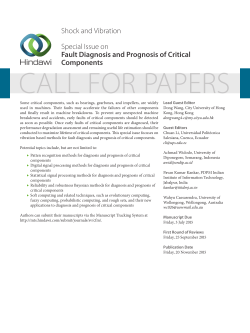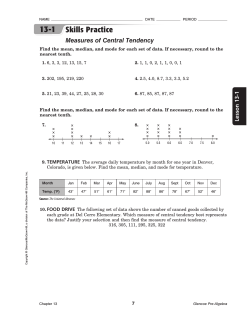
BACKGROUND METHODS Kim N. Chi,1 Celestia Higano,2 Brent
Phase 3 SYNERGY Trial: Docetaxel +/- Custirsen and Overall Survival in Patients with Metastatic Castration-Resistant Prostate Cancer and Poor Prognosis 5009 Kim N. 1 Chi, Celestia 2 Higano, Brent 3 Blumenstein, James 4 Reeves, Susan 5 Feyerabend, Gwenaelle 6 Gravis, Jean-Marc 7 Ferrero, Cindy 8 Jacobs, and Johann de 9 Bono 1BC Cancer Agency, Vancouver, BC, Canada; 2University of Washington/Fred Hutchinson Cancer Research Center, Seattle, WA; 3Trial Architecture Consulting, Washington, DC; 4Florida Cancer Specialists, Fort Myers, FL; 5Urologic University Clinic, Reutlingen, Germany; 6Medical Oncology, Institut Paoli Calmette, Hôpital de Jour, Marseille, France; 7Department d'Oncologie Medicale, Centre Antoine Lacassagne, Nice, France; 8OncoGenex Pharmaceuticals, Inc., Bothell, WA; 9The Institute of Cancer Research and The Royal Marsden NHS Foundation Trust, Sutton, United Kingdom RESULTS SAFETY Survival by Statistical Model Score and Arm (N=984) Incidence of ≥Grade 3 Adverse Events in ≥3% of Patients in Good and Poor Prognosis Subset GOALS OF THIS ANALYSIS CLUSTERIN Clusterin (CLU) is a cytoprotective protein that functions similarly to ATP-independent heat shock proteins. CLU is more highly expressed in aggressive cancers and upregulated in response to treatment such as chemotherapy, hormone ablation, and radiation therapy. CLU is expressed in many malignancies including castration resistant prostate cancer, and is implicated in treatment resistance. Thus, inhibition of CLU may be important in disabling cancer cells’ adaptive defenses, especially in more aggressive or treatment-resistant cancers. Secretory CLU To explore whether inhibition of CLU production is more relevant in patients with poor prognosis Identify well-established baseline prognostic factors relevant to SYNERGY from Control Arm patients (no influence of custirsen) Develop Control Arm multi-variable statistical model relating putative prognostic variables and survival outcome Score patients from Both Arms according to Control Arm statistical model Patients dichotomized into good and poor prognosis subsets Develop simple score to be used to identify poor prognosis patients for future study Null hypothesis: Custirsen effect (between-arm effect) is homogeneous across prognosis scoring classifications Good Prognosis Score Patients Good prognosis: Custirsen treatment Control arm Survival Probability (%) BACKGROUND Custirsen + Docetaxel (n = 240) Docetaxel (n = 252) 32.6 30.4 Median OS, mo HR (95% CI) Poor prognosis: Custirsen treatment Control arm Adverse Event Any Neutropenia Anemia Fatigue Febrile neutropenia Leukopenia Asthenia Diarrhea Back pain Pulmonary embolus Pneumonia 1.02 (0.76 to 1.37), P = 0.901 Poor Prognosis Score Patients Custirsen + Docetaxel (n = 250) Docetaxel (n = 242) 17.0 14.0 Median OS, mo HR (95% CI) 0.73 (0.59 to 0.90), P = 0.004 Time (Months) METHODS CUSTIRSEN SYNERGY: STUDY DESIGN AND RESULTS Randomized, open-label, multinational phase 3 study conducted in 140 centers in 12 countries • mCRPC • Candidates for 1st-line chemotherapy • Stratified by opioid use and radiographic progression N = 1022 R A N D O M I Z E D 1:1 • Docetaxel 75 IV q3w • Prednisone 10 mg qd mg/m2 n = 512 • Docetaxel 75 IV q3w • Prednisone 10 mg qd • Custirsen 640 mg IV x 3 loading doses then q1w mg/m2 n = 510 Endpoints Primary • OS Secondary • Safety • Proportion of patients alive and without radiographic progression on day 140 Exploratory • Serum clusterin and OS • PSA trends • Pain and analgesic use Final analysis following a target 509 deaths to assure 90% power for hypothesized HR 0.75, with one-sided type I error of 0.025 and type II error of 0.1 Survival Probability Overall Survival for SYNERGY (N=1022) Median OS, mo* HR (95% CI) P value (2-sided) Custirsen treatment Control arm Docetaxel + Docetaxel Custirsen (n = 512) (n = 510) 23.4 22.2 0.93, 0.78-1.11 0.42 *Survival compared using a stratified log-rank test and included all randomized patients STATISTICAL MODEL SCORE Prognostic statistical modeling based on Control Arm only data • Survival as a function of multiple baseline covariates using proportional hazards regression • Up to third degree interactions available for inclusion with term selection based on hierarchical step-down • Continuous variables also evaluated as overall median-dichotomized Selected Control Arm statistical model included following dichotomous baseline covariates (and some interactions): • Karnofsky Performance Status ≤ 80 • Liver metastasis present • Opioid use for prostate cancer pain • Hemoglobin < 124 g/L • LDH ≥ 331 IU/L • PSA ≥ 59 ng/mL • Alkaline phosphatase ≥ 92 U/L Coefficients used to compute “statistical model score” of patients in both arms Statistical model score evaluated by dichotomizing at overall median of both arms, classifying patients as “poor” versus “good” prognosis Good prognosis: Custirsen treatment Control arm Docetaxel (n = 295) 29.4 27.7 Median OS, mo HR (95% CI) Custirsen + Docetaxel (n = 208) Docetaxel (n = 201) 16.0 13.7 Median OS, mo HR (95% CI) Time (Months) 0.73 (0.58-0.92), P = 0.008 *Negative Prognostic Factors: Karnofsky Performance Status ≤ 80%; presence of liver metastasis; hemoglobin < 120 g/L; LDH ≥ 360 IU/L; PSA ≥ 150 ng/mL Good Prognosis Custirsen + Docetaxel (n = 240) Any Time to treatment (median, mo) Abiraterone Time to treatment (median, mo) Enzalutamide Time to treatment (median, mo) Cabazitaxel Time to treatment (median, mo) Poor Prognosis Docetaxel (n = 252) Custirsen + Docetaxel (n = 250) Docetaxel (n = 242) 79% 81% 74% 74% 10.7 10.6 8.4 8.0 55% 60% 55% 53% 13.4 12.8 9.6 9.4 28% 26% 16% 17% 22.1 22.3 15.4 12.8 20% 25% 16% 14% 25.7 24.9 14.9 13.3 Time to PSA Progression For Poor Prognosis Subgroup By Statistical Model Score and PCWG Criteria PCWG1 Criteria Custirsen + Docetaxel (n=247) % Docetaxel (n=235) % 80 33 17 12 10 9 8 6 4 4 4 66 20 9 11 5 6 3 3 5 4 3 CONCLUSIONS Use Of Post-Protocol Therapies In this exploratory analysis, mCRPC patients with poor prognosis treated with custirsen/docetaxel/prednisone had improved survival as compared to docetaxel/prednisone when used as first-line therapy. This observation is consistent with custirsen’s mechanisms of action to alter treatment resistance; in patients with poor prognostic features and increased treatment resistance, custirsen may have greater benefit by preventing or reducing CLU production within tumor cells. Use and timing of post-protocol therapy was similar between treatment arms. Although custirsen/docetaxel/prednisone is associated with some increased hematologic and gastrointestinal toxicity, the overall adverse event profile appeared similar between patients in the good and poor prognosis subgroups. Further evaluation of custirsen in patients with poor prognosis disease is warranted and is on-going in the AFFINITY trial (NCT01578655). PCWG2 Criteria ACKNOWLEDGEMENTS This research was supported by OncoGenex Technologies Inc (Bothell, WA). Clinicaltrials.gov identifier: NCT01188187. Note: all are established prognostic factors in prostate cancer 4,5 Custirsen + Docetaxel (n = 245) Abbreviations: IV, intravenous; mCRPC, metastatic castration-resistant prostate cancer; mo, month; PCWG, Prostate Cancer Working Group; PSA, prostate-specific antigen; q1w, weekly; q3w, every 3 weeks; qd, daily; OS, overall survival Any Neutropenia Anemia Fatigue Febrile neutropenia Leukopenia Asthenia Diarrhea Back pain Pulmonary embolus Pneumonia 1.00 (0.78 to 1.29), P = 0.979 Median, mo HR (95% CI) Custirsen + Docetaxel (n = 245) Docetaxel (n = 234) 7.9 6.4 0.75 (0.60-0.93) REFERENCES Poor Prognosis Poor Prognosis Time (Months) Adverse Event Poor Prognosis (≥2 of 5 Negative Prognostic Factors*) Poor prognosis: Custirsen treatment Control arm SIMPLIFIED PROGNOSTIC INDEX Findings from statistical model score used to develop simplified 5-criteria prognostic index Criteria for prognostic index: (1) matches closely prognostic performance of the statistical model score, (2) identifies sufficient proportion of poor prognosis patients, and (3) easy to implement Index selected classifies patients as “poor” prognosis based on having 2 or more of following 5 features: • Karnofsky Performance Status ≤ 80% • Presence of liver metastasis • Hemoglobin < 120 g/L • LDH ≥ 360 IU/L • PSA ≥ 150 ng/mL Custirsen + Docetaxel (n = 283) Poor Prognosis (n=482) % 73 26 13 11 7 7 5 4 4 4 3 Incidence of ≥Grade 3 Adverse Events in ≥3% of Patients in Poor Prognosis Subset By Arm Good Prognosis (<2 of 5 Negative Prognostic Factors*). Survival Probability (%) Custirsen is a second-generation antisense oligonucleotide (ASO) designed to bind to CLU mRNA, resulting in inhibition of production of human CLU protein. Preclinical studies demonstrate enhanced efficacy of chemotherapy when combined with custirsen and clusterin inhibition, including reversing taxane resistance. A phase 1 pre-surgery study determined that clusterin inhibition by custirsen in prostate cancer tissues was dose-dependent, with a biologically effective dose of 640 mg.1 A randomized phase 2 study in patients with mCRPC showed that the addition of 640 mg custirsen to docetaxel plus prednisone (DP) reduced serum clusterin by 26% and prolonged overall survival (OS) vs. DP alone (23.8 vs. 16.9 mo; Cox regression hazard ratio [HR] 0.50; 95% confidence interval [CI] 0.29-0.87).2 The SYNERGY study (OGX-011-11) was a randomized study of docetaxel/prednisone +/custirsen and enrolled 1022 patients. Following 509 deaths, the median OS was 23.4 months (m) vs. 22.2 m for the custirsen and control arms, respectively (HR 0.93; P = 0.42).3 Survival by Simplified Prognostic Index and Arm (N=984) Good Prognosis (n=484) % 65 25 3 8 11 6 5 5 2 4 3 Median, mo HR (95% CI) Docetaxel (n = 234) 8.2 7.4 0.82 (0.64-1.05) 1Chi KN, et al. J Natl Cancer Inst 2005;97(17):1287-96. 2Chi KN, et al. J Clin Oncol 2010;28(27):4247-54. 3Chi KN, et al. Ann Oncol 2014;25(suppl 4):iv256. 4Halabi S, et al. J Natl Canc Inst 2013;105:1729-37. 5Halabi S, et al, J Clin Oncol 2014;32(7):671-677. ASCO MAY 2015
© Copyright 2025










